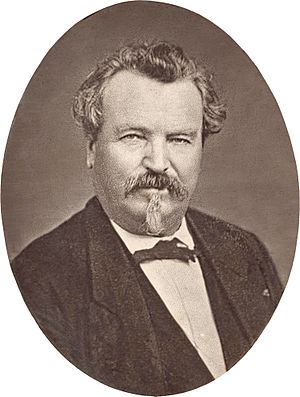Pierre Trémaux facts for kids
Quick facts for kids
Pierre Trémaux
|
|
|---|---|

Portrait of Pierre Trémaux, 1866
|
|
| Born | 20 July 1818 Charrecey, France
|
| Died | 12 March 1895 (aged 76) Tournus, France
|
| Nationality | French |
| Education | École des Beaux-Arts |
| Known for | architect, illustrator, author and photographer |
| Movement | Orientalist |
| Awards | Chevalier, Légion of Honour; Prix de Rome |
Pierre Trémaux (born July 20, 1818 – died March 12, 1895) was a talented French architect. He was also a photographer who focused on the Middle East and North Africa, a style called Orientalism. Besides that, he wrote many books about science and different cultures.
Contents
Life and Adventures
Pierre Trémaux was born in a small town in France called Charrecey. He came from a simple family. We don't know much about his early life or his last years.
Pierre was very good at many things. In 1840, he joined the École des Beaux-Arts, which is a famous art school in Paris. In 1845, he won the second Prix de Rome for architecture. This was a big award for young artists and architects. After his training, he worked as an architect. He was interested in how cities are planned and even in the building of the Suez Canal in Egypt.
Pierre loved natural history, which is the study of nature. He traveled a lot between 1847 and 1848. He visited places like Algeria, Tunisia, Upper Egypt, Sudan, and Ethiopia. During these trips, he drew many pictures. He was also one of the first people to take photos in these areas. He traveled up the Nile River to Nubia.
Later, from 1853 to 1854, he went on another photo trip. This time he visited Libya, Egypt, Asia Minor, Tunisia, Syria, and Greece. He spent seven years exploring these regions. He came back with many drawings and photos. These pictures were some of the very first ever taken of these places and their people.
His Amazing Work
Photography
Pierre Trémaux took many photos, but only a few have survived. Their condition is not very good today. He made 21 photos and 56 lithographs (prints made from stone) based on his pictures.
A photography expert named Nissan N. Perez said that Pierre's photos show he was interested in anthropology. This is the study of human societies and cultures. If more of his photos had survived, they would have been a very important record of people and customs in the Middle East.
Even so, his published books, like the Voyages series from 1852 to 1862, were special. They were the first books about Egypt, Sudan, Palestine, and other Middle Eastern places that had illustrations based on the author's own photographs.
His Ideas on Evolution
Pierre Trémaux also wrote a book that got a lot of attention. It was called Origine et transformations de l'homme et des autres êtres (Origin and transformations of man and other beings), published in 1865. He showed this book at the 1867 Universal Exhibition in Paris.
In his book, he suggested a theory about how living things change over time. This idea is now known as punctuated equilibria. It suggests that evolution happens in quick bursts of change, followed by long periods of little or no change.
His Publications
Between 1852 and 1868, Pierre Trémaux created many sets of photographic plates. These were used to go along with his writings about the geography, buildings, and people of Africa and Asia Minor. The French government supported these projects. His publications were very high quality and used different art techniques together in new ways.
His surviving images include salted paper prints, engravings, and different types of lithographs.
Some of his Books:
- Voyage en Éthiopie, au Soudan Oriental et dans la Nigritie, Hachette, 1852 (This book was about his travels in Ethiopia and Sudan.)
- Origine et transformations de l'homme et des autres êtres, Hachette, 1865 (This is the book about his ideas on evolution.)
See also
- Architectural photography
- Architectural photographers
- History of Photography
- Orientalism
- Punctuated equilibrium

